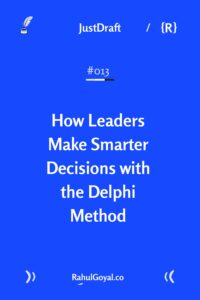How to Apply the Delphi Method for Better Decisions
Have you ever sat in a meeting where only the loudest voices shaped the final decision, leaving behind valuable ideas? This is a common pitfall in group decision-making processes. Enter the Delphi Method—an approach that eliminates bias and leverages collective intelligence for better decisions.
One Topic: Why The Delphi Method Works
In typical discussions, hierarchy or dominance often overshadows diverse perspectives. The Delphi Method flips the script by anonymizing contributions and focusing solely on the value of ideas. This creates a level playing field where the loudest person doesn’t win, but the best ideas do.
How the Delphi Method Works
Here’s a simplified guide to its process:
- Select Experts: Bring in individuals with relevant knowledge.
- Pose Questions: Start with open-ended surveys to gather initial insights.
- Analyze Responses: Identify key patterns while keeping contributors anonymous
- Share a summary with participants, refine questions, and repeat the process for clarity
- Reach Consensus: After multiple rounds, experts align on the best solutions.
This iterative, inclusive process has applications across fields like business strategy, healthcare, and education. For instance, companies have used it to align product roadmaps or predict future trends with great success.
What You Should Know about Delphi Method
The Delphi Method isn’t just about better decisions—it’s about creating an environment where everyone feels heard. It values inclusivity and ensures that no great idea is left behind. Imagine how this could transform your leadership style or organizational culture!
Read last week’s JustDraft newsletter about Progressive Ambition
Two Quotes
The strength of a team is in its diversity of thought, not the volume of voices.
Inclusive leadership doesn’t amplify a single voice—it creates harmony among many.
One Passage From A Book
Great decisions aren’t made in isolation—they emerge from a group’s collective intelligence. This isn’t about putting a few people in a room and hoping for the best. It’s about structured interaction where each person’s perspective is valued. When ideas are shared without fear or favor, magic happens. Leaders who understand this don’t dictate—they facilitate. They create conditions for open dialogue, ensuring every voice is heard and every idea considered. Collaboration isn’t chaos; it’s a deliberate process of harmonizing individual contributions into a powerful collective vision.
From “Group Genius: The Creative Power of Collaboration” by Keith Sawyer

